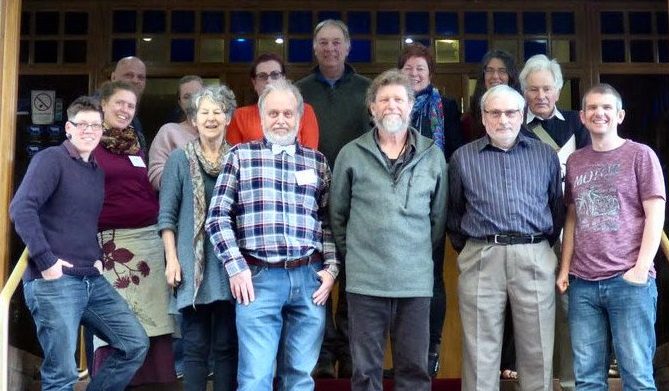Compiled by Kate Atchley from texts by Ewan Campbell, Em Mackie and Gavin Ramsay. (Article first published in The Scottish Beekeeper, July 2017)
On 1 April at the Lovat Hotel in Perth, almost 80 members of the newly-formed Scottish Native Honey Bee Society (SNHBS) met to launch and help to establish priorities for the society. In this article we offer news of the launch event as well as confirmation of the society’s aims and initial activities.
“We have reached a crucial juncture for the survival of our own Scottish honey bees”
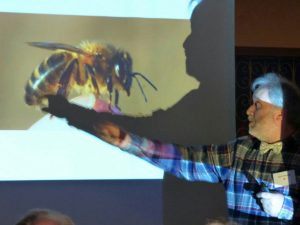 This statement by SNHBS’s chair, Gavin Ramsay, encapsulates so much of what we, as a society, are about. From discussions started nearly three years ago, a small group of similarly minded beekeepers and enthusiasts began to draw on the rich heritage of native bee breeding and research in Scotland in order to try and conserve these bees through education, identification and propagation of stocks.
This statement by SNHBS’s chair, Gavin Ramsay, encapsulates so much of what we, as a society, are about. From discussions started nearly three years ago, a small group of similarly minded beekeepers and enthusiasts began to draw on the rich heritage of native bee breeding and research in Scotland in order to try and conserve these bees through education, identification and propagation of stocks.
The launch meeting on 1 April represented a culmination of a lot of work from the founding committee but is only the beginning for the fledgling society. It was great to see so many like-minded beekeepers attending and the enthusiasm in the room throughout the day was palpable. In his opening address, Gavin announced that membership had past the 100 mark within just two months.
“Mr Black Bee” opens the event
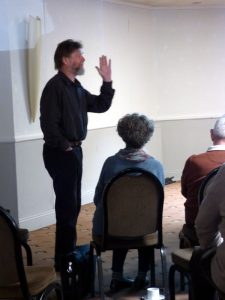
A tour de force presentation from Colonsay native bee breeder Andrew Abrahams, titled simply “Conserving black bees in Scotland”, was a fitting opener. Andrew spoke of the reasons we should aim to conserve native bees and past and current distribution of Apis mellifera races across Europe. We were then treated to a history of the major landmarks in black bee history in the UK, up to the current synthesis that locally adapted bees are more disease resistant and prepared for our climate.
Andrew then took us through a whirlwind history of his beekeeping exploits on Colonsay, from summer 1978 up to the present, and the island’s protected status as a native bee reserve. He touched on black bees globally, the genetics of native bees and, more soberly, some of the issues we will face with propagation in poor weather, genetic inbreeding and costs.
Andrew’s direction for the society chimes with many of us; identify stocks, breed in isolation but with cooperation.
DNA sequencing
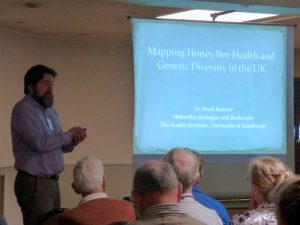
Mark Barnett, from the world famous Roslin Institute, then gave a great talk on a recent DNA sequencing project on bees across the UK. He shared some insights into the techniques and analysis that can be done to look at stocks and identify our best examples of native bees. The talk gave us encouragement that there are still good native honey bee stocks in parts of Scotland, including the Borders.
From Pandas to Honey Bees …
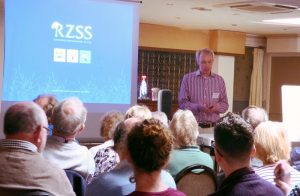 Iain Valentine gave an inspiring and thoughtful seminar on conservation. He spoke about his experience with conserving Giant Pandas but more generally on the pitfalls, obstacles but also high points of trying to protect some of our most endangered wildlife.
Iain Valentine gave an inspiring and thoughtful seminar on conservation. He spoke about his experience with conserving Giant Pandas but more generally on the pitfalls, obstacles but also high points of trying to protect some of our most endangered wildlife.
He drew parallels between what SNHBS aims to do for the black bee and what many conservation groups attempt. His message was hopeful and pretty rousing. I know that a lot of members chalked this up as a high point of the launch day! Iain also suggested that, as a conservation group, we should be able to tap into funding streams to carry out large-scale screening of stocks, promoting queen rearing and related activities.
Short and not all so sweet
There followed a series of quickfire sessions covering current breeding projects in the Ochils, Ardnamurchan and Loch Ewe, as well as Gavin explaining how to identify native honey bees (see Identifying native honey bees) and John Durkacz taking us through the history of native bees in Scotland (see History of the Native Honey Bee in Scotland).
The breeding projects had all been established prior to the establishment of SNHBS but are great examples of what we should be aiming to support. Hopefully, in a few years there will be similar projects springing up across Scotland from Aberdeen to the borders. Sadly, news from Ardnamurchan was disappointing: after two notoriously poor Summers, many of the colonies failed over the winter. It seems they suffered a lack of adequate pollen and did not, as many might assume, fail as a result of disease. This is a warning for us to take care when siting bees in marginal areas.
The afternoon was devoted to membership participation. Usually when 70 beekeepers get together in a room there are hundreds of varied and conflicting arguments but it has to be said that it was remarkably sanguine! Everyone broke into geographically-arranged discussion groups, each with a facilitator, followed by a plenary discussion. The members’ expressed priorities have helped to shape to society’s plans already and will continue to do so.
The final business of the day was the appointment of trustees and committee members having first discussed the various essential roles involved.
Coming soon ……
What have we been planning since 1 April? Here is a roundup of what we hope to be offering SNHBS members over the coming year. Space on courses may be available to non-members too.
Summer Queen Rearing Workshop
The Ochils Breeding Group are offering a practical one-day workshop near Perth in August. Two dates are available, Saturdays 5 and 19 August. The aim is to provide hands-on and classroom sessions to show people how to raise, mate and introduce queens from selected breeder queens. Everyone will have an opportunity to graft to produce queens and, if the weather cooperates, they will be able to take home their own Scottish dark native honey bee queen ready to emerge a day or two after the workshop (one we prepared earlier!).
Winter Workshop on Selecting and Breeding Scottish Native Honey Bees
A one-day course will be offered during the winter demonstrating and teaching the various techniques required to run a breeding programme. This will include guidance on:
- selecting stocks for trueness to type using both morphological traits and wing morphometry
- selecting for desirable traits
- mating site design
- bee genetics
- pitfalls in selection systems.
Future distribution of breeding material
This Summer, a group within the SNHBS committee, are testing simple means of distributing breeding material to enable everyone to raise their own Scottish dark native honey bee queens. If we can develop successful methods to deliver eggs or young larvae to remote beekeepers, which can then be used to generate queens, then we will extend this to the full membership in 2018. This could be a useful means of converting the genetics of discrete areas in the future: the first round replaces queens that mate with local drones, the second round provide virgins to mate with the drones coming from the first generation introductions.
Survey looking for native bees
A priority is a properly-planned search for local populations of Scottish native honey bees. We believe there are examples of native honey bees yet to be identified around Scotland and are looking to partner with researchers able to verify samples using morphology and DNA methods. This survey will be launched next year but you can start now by looking out for beekeepers with the right kind of bee in your area! See Gavin Ramsay’s article, Identifying native honey bees.
Do let us know what you find.
Please lend a hand
Those keen to support the aims of the society are encouraged to:
- Set up bee Improvement groups with like-minded others: SNHBS encourage the formation of local native bee groups and would love to hear regular updates from you.
- Scout about: SNHBS are keen to identify potential Conservation Areas and sites for mating stations around Scotland. Get in touch with what you find.
- Get writing: we are looking for the wordsmiths that might contribute to future newsletters and articles for the website. If you have a story with a black bee angle then please put pen to paper or fingers to keypads and get writing.
- Artistic flair? Are any artists or graphic designers amongst our beekeeping friends who might be interested in creating, first and foremost, our logo but also posters or flyers. Let us know if you’re interested in joining our bank of writers and artists.
- Organise local events and workshops: one of our aims at SNHBS is to get beekeepers skill-sharing. If you have the confidence and experience to run queen rearing workshops in your local area or if your association would like to organise a day event promoting the native bee or bee improvement skills, then SNHBS would be happy to support and advise in any way we can.
- Volunteering: Thanks to those of you who have already volunteered for SNHBS. If you would like to add your name to SNHBS’s volunteer list, please contact Em at secretary@snhbs.scot.
Compiled by Kate Atchley from texts by Ewan Campbell, Em Mackie and Gavin Ramsay.

